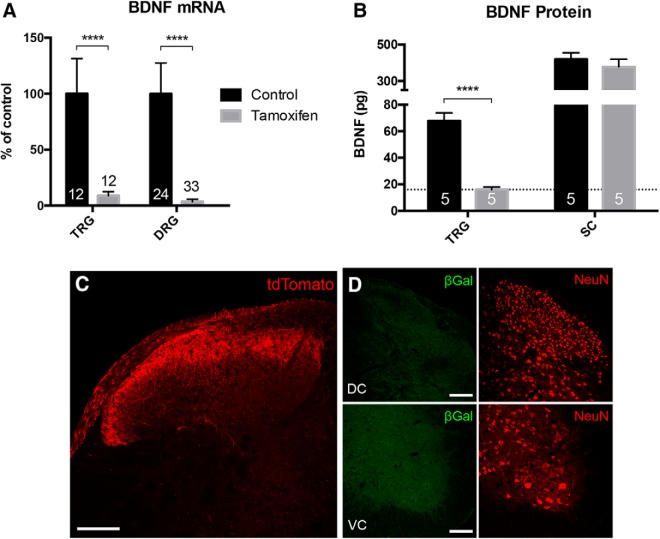Figure 5.
Advillin-CreERT2-mediated primary afferent deletion of BDNF. A, Compared to control animals treated with vehicle, qRT-PCR of DRG and trigeminal ganglia (TRG) showed highly significant depletion of BDNF (∼91% and ∼97%, respectively) after tamoxifen-induced Cre recombination. B, ELISA showed that BDNF peptide was reduced in the TRG, but not spinal cord (SC). The dotted line indicates the detection limit of the ELISA; values below this line were statistically indistinguishable from zero. C, Consistent with the qPCR and ELISA findings, after crossing Advillin-CreERT2 animals with a tdTomato reporter line and treating with tamoxifen, we only detected tdTomato in presumptive primary afferent terminals of the spinal cord dorsal horn. D, Furthermore, double transgenic Advillin-CreERT2/floxed-LacZ mice did not exhibit any β-Gal staining in the spinal cord after tamoxifen. Together, these results indicate that Advillin-CreERT2 does not drive Cre expression in the spinal cord, the neurons of which are indicated by NeuN immunostaining (red in D) and that tamoxifen-induced recombination is selective for sensory ganglia. Data are mean ± SEM. Statistical significance was determined by multiple t tests with Bonferroni correction for multiple comparisons; **p < 0.01, ****p < 0.0001. Numbers of animals are indicated in A, B. Scale bars = 100 μm. DC: dorsal cord; VC: ventral cord.

